
This year's award goes to Howard MacCord, who has has helped shape the development of archeology, not only in Maryland but also in the Mid-Atlantic States. Stimulated by Howard Carter's discovery of King Tutankhamen's tomb in the 1920s, Howard MacCord's early years in Washington D.C. gave him easy access to the Smithsonian Institution, where he met such anthropologists as T. Dale Stewart, Waldo Wedel, Neil Judd, Frank Setzler and Ales Hrdlicka.
He found his first "arrowheads" at a Daughters of the American Revolution summer camp in Charles County in 1932. Thus, Howard began a systematic survey of the rivers of tidewater Maryland including the Patuxent (from Benedict to Laurel), the Potomac (in Charles and Prince George's Counties), including Port Tobacco, Zekiah Swamp, Mattawoman Creek, Piscataway Creek and the Anacostia River.
Howard's first professional dig occurred in May of 1933 when he assisted Judge William Graham and T. Dale Stewart in excavating a Potomac Creek phase ossuary at Port Tobacco. In the summer of 1939, Alice Ferguson hired him and Carl Manson to excavate at her Accokeek Creek Site. Volunteering in 1939 at the National Museum, Howard learned animal identification from Gerritt Miller and Remington Kellogg of the Division of Mammals.
While stationed at Fort Meade during World War II, Howard and Carl Manson finished the Keyser Farm report, where they had dug in 1940. Dr. James B. Griffin studied and published the ceramic type description of Keyserware. In 1947, Howard and Carl again dug in Maryland at the Popes Creek Site on the Potomac. Between 1947 and 1948, Howard completed the first archeological survey paid for by Virginia (in the Shenandoah Valley).
In 1948, Howard began his second career in the Army, retiring as a full Colonel in 1962. From 1954 to 1957, Col. MacCord was stationed, again, at Fort Meade. In September and October of 1954, Howard was invited to organizational meetings of the reconstituted Archeological Society of Maryland. T. Latimer Ford, Thomas Mayr, Eleanor Wilcox, Richard Sterns and Howard MacCord agreed to form the society as a program of the Maryland Academy of Sciences. Although the ASM, Inc. formed in 1964, it was not until 1970 that both organizations merged.
In 1957, Richard Sterns and Howard MacCord directed ASM members at a Late Woodland site in Benedict on the Patuxent. After his retirement in 1962, Howard convinced the Commonwealth of Virginia to create a state-wide archeology position, which he held until 1976.
Howard MacCord has made a lasting contribution to the early archeology of Maryland and the Mid-Atlantic States. He is an example of the difference that one individual can make in saving and sharing the archeological past.